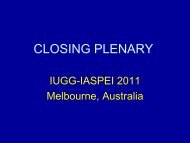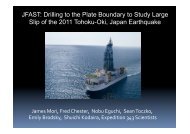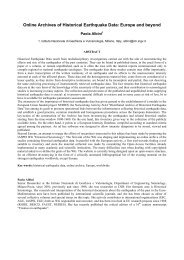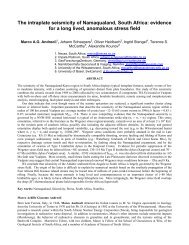A Preliminary Reconnaissance Report on August 11 2012 ...
A Preliminary Reconnaissance Report on August 11 2012 ...
A Preliminary Reconnaissance Report on August 11 2012 ...
You also want an ePaper? Increase the reach of your titles
YUMPU automatically turns print PDFs into web optimized ePapers that Google loves.
A <str<strong>on</strong>g>Preliminary</str<strong>on</strong>g> <str<strong>on</strong>g>Rec<strong>on</strong>naissance</str<strong>on</strong>g> <str<strong>on</strong>g>Report</str<strong>on</strong>g> <strong>on</strong> <strong>August</strong> <strong>11</strong> th <strong>2012</strong>,Varzaghan-Ahar Twin Earthquakes in NW Of IranMehran S. RazzaghiAssistant Professor, Qazvin Branch, Islamic Azad University, Member of IEEAMohsen Ghafory- AshtianyProfessor of Internati<strong>on</strong>al Institute of Earthquake Engineering and Seismology (IIEES)President of Iranian Earthquake Engineering Associati<strong>on</strong> (IEEA)Chairman of IASPEI Commissi<strong>on</strong> <strong>on</strong> Earthquake Hazard, Risk and Str<strong>on</strong>g Ground Moti<strong>on</strong>Introducti<strong>on</strong>At 16:53 of <strong>August</strong> <strong>11</strong>th <strong>2012</strong> (local time) an Mw6.4 (NEIC) earthquake occurred near cities of Ahar andVarzeghan in the East-Azerbaijan province in northwest of Iran. This event was followed by anotherevent at 17:04 (<strong>11</strong> minutes after the first shock) with Mw6.3 (NEIC) that based <strong>on</strong> precise locati<strong>on</strong> of thelocal seismic network (Institute of Geophysics, University of Tehran; IGUT) is located just below the firstevent at a depth of around 16km. Following this twin earthquakes, more than 20 villages such asZangabad, Gourdeh, Dino, Bajebaj, Sarand, and Shahsavar have completely destroyed and cities ofVarzaghan, Ahar and Heriss suffered different levels of the damage. The Varzeghan-Ahar twinEarthquakes caused panic am<strong>on</strong>g 2 milli<strong>on</strong> people in the Azerbaijan province, making many people sleepoutside for 2 nights. The earthquake killed 327 people, claimed more than 3000 injuries and left morethan 30000 homeless. Buildings in the stricken area experienced different levels of damage. Most of theadobe buildings in villages were collapsed and several mas<strong>on</strong>ry and framed buildings were damaged.Some of the roads were damaged due to the surface faulting and geotechnical instabilities. Furthermoresome of the bridges suffered damage due to the earthquake but was serviceable after the event. Many ofthe essential facilities (e.g. hospitals) in stricken areas were damaged and some industrial plantsexperienced ec<strong>on</strong>omic loss due to the unsafe shutdown process after the earthquake.Descripti<strong>on</strong> of the EventOn <strong>2012</strong> <strong>August</strong> <strong>11</strong> an earthquake of Mw 6.4 occurred near Ahar and Varzaghan in the EasternAzerbaijan of NW Iran, approximately 60 km northeast of the Tabriz (Figs 1 and 5). Although of <strong>on</strong>ly
moderate size, this earthquake which followed with another large event (Mw 6.3) ~<strong>11</strong> minutes later,caused about 327 causalities and destroyed severely more than 20 villages, and damaged many building intwo Ahar and Varzaghan cities located around 20 km distance of the main shocks.Different estimates of the main shocks epicenters have been made (Fig. 1). The most precise locati<strong>on</strong> isthe estimate from the Institute of Geophysics at Tehran University (IGTU), based <strong>on</strong> their permanentseismic stati<strong>on</strong>s in the NW Iran (Tabriz Seismic Network). Relocati<strong>on</strong> of the main shocks (Dr. Moradifrom IGTU, pers<strong>on</strong>al communicati<strong>on</strong>) indicates that both events have occurred at the same coordinates(38.41N 46.78E) located approximately 15 km southeast of Varzeghan and ~25 km southwest of Ahar(Fig. 5). The focal depths of the first and sec<strong>on</strong>d shocks were determined 9 and 16 km respectively. Thefocal mechanisms of the both events are c<strong>on</strong>sistent with right-lateral strike-slip faulting <strong>on</strong> E-W trendingfault parallel to aftershocks sequence and South Ahar fault (Fig1, 5). However, the sec<strong>on</strong>d main shock(Mw 6.3) shows a c<strong>on</strong>siderable reverse comp<strong>on</strong>ent (CMT soluti<strong>on</strong>, Harvard University). The fieldobservati<strong>on</strong> also revealed the existence of E-W trending right-lateral strike-slip surface rupture (Fig. 2).The str<strong>on</strong>gest SGM accelerati<strong>on</strong> PGAs of the first and the sec<strong>on</strong>d earthquakes were 0.427g and 0.534g(uncorrected records) respectively, recorded at BHRC-Varzaghan stati<strong>on</strong>, see Figure 3[3]. The variati<strong>on</strong>of the recorded PGA in the regi<strong>on</strong> is shown in Figure 4. Until Aug 20, <strong>2012</strong> more than 1000 aftershockshave occurred in the regi<strong>on</strong>, in which more than 100 had magnitude larger than 3 (Fig 5). This figureshows the E-W trending South Ahar fault which seems to be the causative fault resp<strong>on</strong>sible for the Mw6.4 Varzaghan-Ahar earthquake. Figure 6 shows the daily number of major recorded aftershocks within 8days after the earthquake.Figure 1. The epicentral area of the <strong>2012</strong> Varzaghan-Ahar twin earthquakes. Main shocks epicentersestimates are the stars in red (from IIEES), green (preliminary locati<strong>on</strong> from the Institute of Geophysics atTehran University), and blue (from the NEIC)
Figure 2. The feature of the surface ruptures indicating <strong>on</strong> right-lateral strike-slip faulting [2](a)(b)Figure 3. Accelerati<strong>on</strong> time histories of the main events recorded at Varzaghan stati<strong>on</strong> (a) the 1 st event,PGA=0.436g (b) the 2 nd event, PGA=0.544g [3]
Figure 4. Variati<strong>on</strong> of PGA in the affected area [IIEES]Figure 5. The locati<strong>on</strong>s of the aftershocks recorded at local permanent stati<strong>on</strong>s of IGTU. A localtemporary seismic network of 17 stati<strong>on</strong>s, installed by IIEES two days after the man shock is shown asred triangles. The locati<strong>on</strong>s of the main shocks based IGTU relocated epicenters (green stars) and theirfocal mechanisms (CMT soluti<strong>on</strong>) are presented as well (IIEES, Prepared by Dr. M. Tatar).
Figure 6. Number of the major aftershocks until <strong>August</strong> 18 th <strong>2012</strong>Geotechnical AspectsSeveral landslides and rock falls occurred in the stricken area, as shown in Figures 7. Most of theobserved landslides and rock falls were happened next to the Khajeh- Ahar and Khajeh-Varzaghan roads.The distances of the most observed rock falls to the epicenter were less than 20 Km. No evidence ofliquefacti<strong>on</strong> and/or sand boiling observed in the stricken area.Figure 7. Landslide and rock fall near Chaykandi Village [2]
Performance of the Residential BuildingsMost of the collapsed and damaged houses in the effected villages, as shown in Figure 8, were adobe andunreinforced mas<strong>on</strong>ry buildings.The main failure modes of these types of building are the failure of heavyroofs, in plane failure of walls and out of plane failure of wallsas shown inFigure 9. In general,performance of the brick mas<strong>on</strong>ry buildings was noticeably better than of adobe <strong>on</strong>es. Both framed (steeland RC) structures and brick mas<strong>on</strong>ry buildings exist in urban areas. No observable structural damageoccurred in residential buildings of the Herris city. Few n<strong>on</strong>structural damages observed in thesebuildings. As shown in Figure 10 residential buildings of different types damaged in both Ahar andVarzaghan cities and villages of stricken area. Infill walls of some of the buildings cracked in northernparts of Tabriz city. It should be noted that buildings with minimum code requirements have survived theearthquake as indicated in Figure <strong>11</strong>.Figure 8.Overall view of the damaged area. It shows that most damages were due the collapse of adobebuildings [Fars News Agencies]
Figure 9. Failure of heavy steel jack-arch and c<strong>on</strong>crete roofs, and walls of UnreinforcedMas<strong>on</strong>rybuildings (Bastami and Mehr News Agency)Figure 10. Performance of semi-steel frame buildings in villages (Mehr News Agency and Bastami)Figure <strong>11</strong>. Buildings with minimum code requirement have survived the earthquake (Mehr News Agency;Kalantari-IIEES and Bastami-IIEES)
Performance of the Essential FacilitiesHospitals: Performance of Hospitals was not acceptable. Main Heriss hospital with RC moment resistingframe experienced small structural damage due to occurrence ofplastic hinge and failure of many columnsnear to beam-to-column joint, as shown in Figure 12. All of the observed plastic hinges were located inthe columns of the first floor. Some of the columns experienced shear cracks next to the openings of theinfill walls. In additi<strong>on</strong> to the abovementi<strong>on</strong>ed failures, as shown in this figure, diag<strong>on</strong>al cracks observedin some of the beams net to the column joint. It seems that the main reas<strong>on</strong> for unacceptable performanceof the structural system was poor quality of c<strong>on</strong>structi<strong>on</strong> and low quality of c<strong>on</strong>crete. Such a performanceoccurred because of weakness of the cementitious matrix and/or in sufficient b<strong>on</strong>dage of cement pasteand the aggregates.Figure 13show shows that n<strong>on</strong>-structural damages <strong>on</strong> the hospital such as diag<strong>on</strong>alcracking and out of plane failure of infill walls, failure of facades and false ceilings were the major failuremodesof the n<strong>on</strong>-structural elements. The hospital was not operable after the earthquake. The Bagher-Al-Oloom Hospital in Ahar city also suffered remarkable n<strong>on</strong>structural damages and put out of commissi<strong>on</strong>after the earthquake [2]. In plane failure of infill walls, failure of false ceilings and overturning of medicalequipment were the major failure mode of n<strong>on</strong>-structural comp<strong>on</strong>ents in this hospital.Universities: No observable structural damage happened in universities and dormitory buildings in Ahar,Varzaghan and Herris. Several n<strong>on</strong>-structural failures occurred in educati<strong>on</strong>al and dormitory buildings ofVarzaghan Islamic Azad University. There were no human losses or injuries have been reported in theuniversities.Figure 12. Herris hospital structural damage to the: Plastic hinges <strong>on</strong> beam-columns joint and diag<strong>on</strong>alcrack of the column.
Figure 13. N<strong>on</strong>structural damage to Herris hospital:Dams: Sattarkhan and Herris embankment dam is the most important dam in the affected area, thatremained operati<strong>on</strong>al, as shown in Figure 14. A crack parallel to upstream-downstream directi<strong>on</strong> wasobservable in pavement of the crest of the Sattrakhan Dam [2].Gas stati<strong>on</strong>s: No structural damage observed in the gas stati<strong>on</strong>s in the affected area. But most of the CNGgas stati<strong>on</strong>s went under inspecti<strong>on</strong> in order to ensure their safe operati<strong>on</strong>. Only few CNG gas stati<strong>on</strong>swere serviceable, and c<strong>on</strong>sequently a l<strong>on</strong>g queue of cars formed for getting gas.Roads and Bridges: Although some of the bridges in the affected area suffered structural damage, all ofthe observed bridges were fully serviceable after the earthquake. Figure 15, indicates a bridge with minordamage. The pavement of some of the roads cracked due to the fault rupture and geotechnical instabilitiesbut the roads was serviceable after the earthquake.Industrial plants and Factories: Most of the important industrial plants and factories (e.g. Petrochemicalplant, refinery, cement facory, etc.) were located near Tabriz and Soufyan cities, more than 45 Km farfrom the epicenters of the main earthquakes. It is estimated that the PGA of the earthquake in this z<strong>on</strong>ewas less than 0.05g. No observable structural damage is reported in the industrial plants. The operati<strong>on</strong> insome of the plants was partially stopped because of the safe shot down operati<strong>on</strong>.DownstreamUpstreamHerris dam (no damage)Sattarkhan dam (some cracks <strong>on</strong> its crest)Figure 14. Sattarkhan and Herris embankment dam with no damage [2]
إFigure 15. A serviceable bridge after the earthquakes [Bastami, IIEES]Disaster Resp<strong>on</strong>seThe search and rescue operati<strong>on</strong> have d<strong>on</strong>e by survived people, NGOs and governmental organizati<strong>on</strong>s.Just four hours after the earthquake 87 killed and 400 injured people have found by search and rescueteams. The number of killed and injured people reported in 48 hours after the earthquake is indicated inFigure 16, which indicate the effectiveness of the search and rescue operati<strong>on</strong>. As shown in this figure,the lowest performance of the search/rescue teams happened between 7 to 13 hours after the earthquakewhich was midnight to early morning. Also as it can be seen in Figure 17, most of the killed peoplereported by hospitals were children and women.Due to the damages in the hospital, the treatment was d<strong>on</strong>e outside in the temporary hospitals setups inthe tents, as it can be seen in Figure 12. Rescue teams had to transmit the injured people to the hospitalsof the nearby cities.A remarkable traffic jam in Tabriz-Varzaghan, Tabriz-Ahar and other primary roads of the affected areawas <strong>on</strong>e of the most troubles of rescue teams. The main reas<strong>on</strong> for such traffic jams was large remarkablenumber of volunteers going to the affected areas for helping the rescue teams.The earthquake caused panic am<strong>on</strong>g about 2 milli<strong>on</strong> people in the Azerbaijan province; make manypeople sleep outside for several nights especially in Tabriz, see Figure 18. The earthquakes claimed morethan 30000 homeless who had to live in emergency shelters, as shown in Figure 19. Following theearthquakes, the presence of NGOs and self-motivated volunteers was remarkable and noticeable; as theyprovided essential needs of victims, see Figure 20. Despite all of the suffering, hope and life c<strong>on</strong>tinues inthe stricken area, as shown in Figure 21.Shortcomings of the crisis management: Disaster managers in this seismic event were not able to c<strong>on</strong>trolthe heavy traffic especially in the first days after the earthquakes. The traffic jam and panic behavior ofthe drivers caused several car accidents which claimed some victims. Different organizati<strong>on</strong>s, presentedinc<strong>on</strong>sistent statistics about the c<strong>on</strong>sequences of the event (e.g. number of killed and/or injured people).Such a situati<strong>on</strong> made the victims of the event worry and caused panic behavior. The emergency shelters(tents) were not suitable for the climate of the earthquake affected area. Although the earthquakehappened in summer, victims of the earthquake had to make fire outside their tents at nights because ofthe cold weather. Sanitary services in the emergency shelters were important needs of the victims. Lack ofpsychological counseling and mental therapies was <strong>on</strong>e of the most shortcomings of the crisismanagement in this earthquake.
Figure 16. The life loss reported at different stages <strong>on</strong> search-rescue operati<strong>on</strong>Figure 17. Gender and age of the killed people
Figure 18. The earthquake made many people sleep outside in TabrizFigure 19. Victims of the earthquake had to live in emergency shelters
Hop[eFigure 20. People self-motivated volunteer resp<strong>on</strong>se (Parsizadeh, Eskandari and Mehr News Agancy)Figure 21. Hope and life c<strong>on</strong>tinues (Mehr News Agancy)References[1] Zareh M., Shahvar M. (<strong>2012</strong>), An Urgent <str<strong>on</strong>g>Report</str<strong>on</strong>g> <strong>on</strong> the <strong>11</strong> <strong>August</strong> <strong>2012</strong>, Mw6.2 and Mw 6.1; AharTwin earthquakes in East Azarbayjan Province of NW Iran, www.iiees.ac.ir[2] Davoodi M., Kalantari A., Mostafazadeh M. (<strong>2012</strong>), Urgent <str<strong>on</strong>g>Rec<strong>on</strong>naissance</str<strong>on</strong>g> <str<strong>on</strong>g>Report</str<strong>on</strong>g> <strong>on</strong> AharEarthquake: Reprt No. 1, www.iiees.ac.ir (in Persian)[3] Building and Housing Research Center (<strong>2012</strong>), Ahar earthquakes of <strong>11</strong> <strong>August</strong> <strong>2012</strong> (East-Azerbaijan), www.bhrc.ac.ir (in Persian)[4] ijan), www.bhrc.ac.ir (in Persian)






